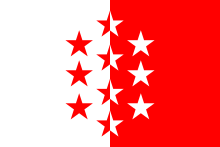Walser people
This article relies largely or entirely on a single source. (September 2020) |


The Walser people are the speakers of the
From the upper Wallis, they began to spread south, west and east between the 12th and 13th centuries, in the so-called
History

The Walser people originate from the Swiss canton of Valais. Around 1300, they started to migrate. As of 2022, the reasons are not historically documented and are speculated to be due to overpopulation, climate change or poverty.
In many places Walser settlers received the "Walser right" (colonist right), that is, personal freedom, with the right to form their own judicial communities and the right of the free hereditary rights of land. When a settler died, the estate passed to his heirs. The "Walser law" was granted against a moderate interest and the obligation to serve in the war.[3]
Geographical distribution
In

In
In Liechtenstein, there is one Walser community: Triesenberg, including Saminatal and Malbun. Until the 1930s, the dialects of Walser German and Romandy based on the French language was still spoken among a few hundred residents.[citation needed]
In
Additionally, Walser communities are reportedly found in
Some Walsers later settled portions of eastern
References
- ISBN 9783946234180.)
{{cite book}}: CS1 maint: multiple names: authors list (link - ^ "Walsertreffen, the great gathering of Walser". Alagna. Retrieved 24 November 2023.
- ^ "Geschichte und Brauchtum". www.gde-mittelberg.at. n.d. Retrieved 20 June 2022.
External links
- Google Map of Walser Settlements 1200 to Present
- International Association of Walser (including those of Wallis canton)
- Walser-Alps
- WM - Piccolo Atlante Linguistico dei Walser Meridionali
- Walser Kulturzentrum - Gressoney-Saint-Jean, Aosta Valley (Italy)
- Indagine sociolinguistica sulle comunità Walser del Piemonte
- Walser village in Italy
